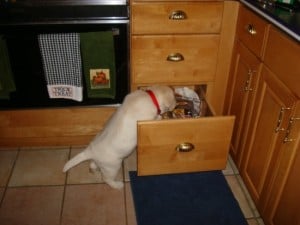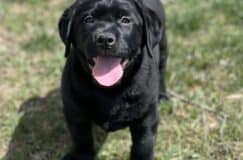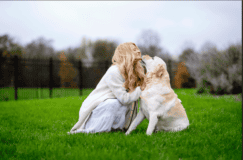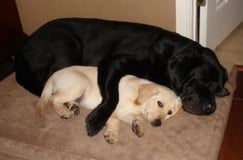STAGGERING household hazards for your pets!!!!
Many common household items can pose a threat to animal companions. Even some items specifically meant for pets could cause health problems.
To protect your pet, simply use common sense and take the same precautions you would with a child. Although rodent poisons and insecticides are the most common sources of companion animal poisoning, the following list of less common but potentially toxic agents should be avoided if at all possible.
Outside hazards
- Antifreeze that contains ethylene glycol has a sweet taste that attracts animals but is deadly if consumed in even small quantities; one teaspoon can kill a seven-pound cat. The HSUS recommends pet owners use a safe antifreeze in their vehicles. Look for antifreeze that contains propylene glycol, which is safe for animals if ingested in small amounts. Ethylene glycol can also be found in common household products like snow globes, so be sure to keep these things out the reach of animals. Read more about antifreeze hazards »
- Cocoa mulch contains ingredients that can be deadly to pets if ingested. The mulch, sold in garden supply stores, has a chocolate scent that is appetizing to some animals.
- Chemicals used on lawns and gardens, such as fertilizer and plant food, can be easily accessible and fatal to a pet allowed in the yard unsupervised.
- De-icing salts used to melt snow and ice are paw irritants that can be poisonous if licked off. Paws should be washed and dried as soon as the animal comes in from the snow. Other options include doggie boots with Velcro straps to protect Fido’s feet, and making cats indoor pets.
- Cans and garbage can pose a danger when cats or smaller dogs attempt to lick food from a disposed can, sometimes getting their head caught inside the can. To be sure this doesn’t happen, squeeze the open end of the can closed before disposing.
- Traps and poisons. Pest control companies frequently use glue traps, live traps and poisons to kill rodents. Even if you would never use such methods to eliminate rodents, your neighbor might. Dogs and cats can be poisoned if they eat a rodent who has been killed by poison (called secondary poisoning).
Trouble on the inside
- Cedar and other soft wood shavings, including pine, emit fumes that may be dangerous to small mammals like hamsters and gerbils.
- Insect control products, such as the insecticides used in many over-the-counter flea and tick remedies, may be toxic to companion animals. Prescription flea and tick control products are much safer and more effective. Pet owners should never use any product without first consulting a veterinarian. Read more about potential poisoning from flea and tick products »
- Human medications such as pain killers (including aspirin, acetaminophen, and ibuprofen), cold medicines, anti-cancer drugs, anti-depressants, vitamins, and diet pills can all be toxic to animals. Keep medication containers and tubes of ointments and creams away from pets who could chew through them, and be vigilant about finding and disposing of any dropped pills.
- Poisonous household plants include azalea, dieffenbachia (dumb cane), lilies, mistletoe, and philodendron, among others. See our full list of poisonous plants »
- String, yarn, rubber bands, and even dental floss are easy to swallow and can cause intestinal blockages or strangulation.
- Toys with movable parts—like squeaky toys or stuffed animals with plastic eyes—can pose a choking hazard to animals. Take the same precautions with pets as you would with a small child.
- Rawhide dog chews may be contaminated with Salmonella, which can infect pets and humans who come in contact with the chews. These kinds of chews should be offered to a pet only with supervision, as they can pose a choking hazard as well.
- Holiday decorations and lights pose a risk to cats and dogs. Keep these items out of the reach of animals, and if possible, confine your pet to an undecorated area while you are out of the home. Read more on holiday choking hazards »
Kitchen Dangers
- Chocolate is poisonous to dogs, cats, and ferrets. Read more on why chocolate is dangerous to dogs »
- Fumes from nonstick cooking surfaces and self-cleaning ovens can be deadly to birds. Always be cautious when using any pump or aerosol spray around birds.
- Leftovers such as chicken bones easily shatter and can choke a cat or dog. Other human foods to keep away from pets include onions and onion powder; alcoholic beverages; yeast dough; coffee grounds and beans; salt; macadamia nuts; tomato, potato, and rhubarb leaves and stems; avocados (toxic to birds, mice, rabbits, horses, cattle, and dairy goats); grapes; and anything with mold growing on it. See our full list of people foods that might harm pets »
Safety first
The HSUS recommends that pet owners use all household products with caution and keep a pet first aid kit (for dogs and cats) and manual readily available. The HSUS has a first-aid book in conjunction with the American Red Cross entitled Pet First Aid: Cats and Dogs. If all of your precautions fail, and you believe that your pet has been poisoned, contact your veterinarian or emergency veterinary service immediately. Signs of poisoning include listlessness, abdominal pain, vomiting, diarrhea, muscle tremors, lack of coordination, and fever.
In case of emergency
The ASPCA Animal Poison Control Center operates a hotline 24 hours a day, seven days a week at 888-426-4435 for a fee of $60 per case. If you call, you should be prepared to provide the name of the poison your animal was exposed to, the amount and how long ago; the species, breed, age, sex, and weight of your pet; and the symptoms the animal is displaying. You’ll also be asked to provide your name, address, phone number, and credit card information.









36 Comments